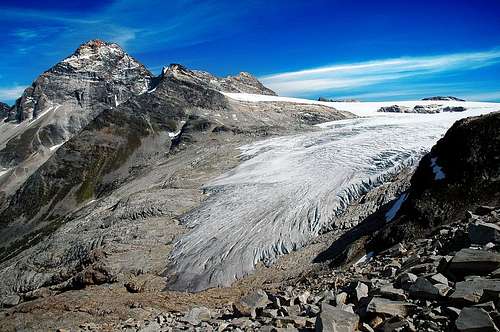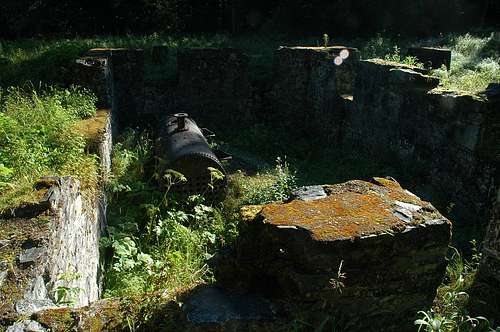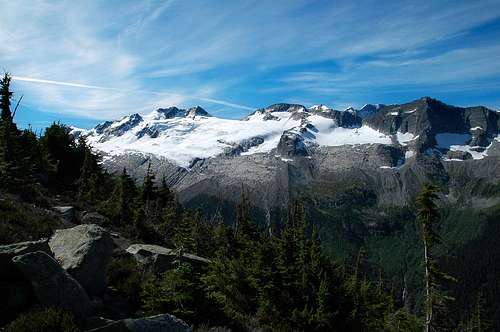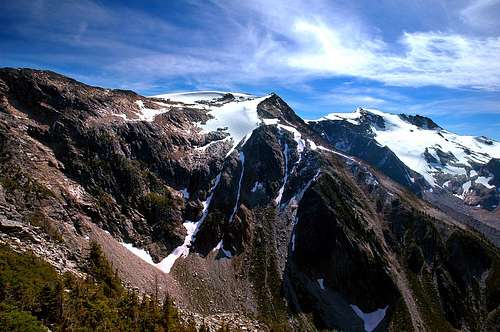-
 15548 Hits
15548 Hits
-
 80.49% Score
80.49% Score
-
 12 Votes
12 Votes
|
|
Mountain/Rock |
|---|---|
|
|
51.23730°N / 117.4653°W |
|
|
Hiking |
|
|
Summer, Fall |
|
|
7398 ft / 2255 m |
|
|
Overview
Glacier Crest is a ridge separating the Illecillewaet Glacier from the Asulkan Glacier in Canada’s Glacier National Park. In reality, the ridge is an arête that was carved out by the two glaciers as they once flowed down the valley. The views from the top are fantastic. Besides the two glaciers mentioned, you get incredible views of Mount Sir Donald, Perley Rock, Eagle Peak, Avalanche Peak, Abbott Ridge, Sapphire Col, the summit of Rogers Pass, and a multitude of peaks situated north of the Trans-Canada Highway.

Geographically speaking, Glacier Crest is located just south of the Rogers Pass summit in the Selkirk Mountains of British Columbia. (Although it lies almost directly south of the Rogers Pass summit, it may be better described as gotten to by driving westbound from the summit and visitor centre buildings there.) The nearest communities are Golden to the east and Revelstoke to the west. Few amenities are found at the summit of Rogers Pass, so you must mostly be prepared beforehand when visiting the park.
The Illecillewaet Glacier, formerly known as the Great Glacier, is very well known due to the historical documentation of its dramatic retreat. Since its earliest recordings in 1887, the toe of the Illecillewaet Glacier has receded approximately 1.5 kilometers. The Illecillewaet Glacier and (to a lesser degree) the Asulkan Glacier first became widely known when the Vaux family of Philadelphia photographed and recorded the expanse and ablation of the Illecillewaet Glacier between 1887 and 1923. Mary, the oldest child, and her brothers, William and George, essentially became North America’s first glaciologists, studying and recording the Illecillewaet with surveying gear and early Kodak cameras. Despite being amateurs, their surveys were some of the most comprehensive of their day and their work has made the Illecillewaet Glacier one of the most thoroughly studied in the world when it comes to its retreat. The Illecillewaet experienced a brief period of advancement during the 1960's and 70's, but continues its ablation today.
Some great historical images of the Illecillewaet and Asulkan Glaciers:
http://www.flickr.com/photos/library_of_congress/3662334839/
http://www.flickr.com/photos/museemccordmuseum/2921302407/
http://www.flickr.com/photos/museemccordmuseum/2918193951/
The Illecillewaet Glacier is the source of the Illecillewaet River, a tributary of the Columbia River. The name “Illecillewaet” comes from a First Nation’s word meaning “fast flowing stream.” Rev. William Spotswood Green was the first to use the name "Asulkan" which he derived from a local First Nation’s dialect and reportedly means "wild goat." Green saw many mountain goats while at the end of this valley in Asulkan Pass.
This area and the trailhead for Glacier Crest are very significant in the history of mountaineering. The trail begins at the former location of Glacier House, a hotel built by the Canadian Pacific Railway (CPR) in 1886. 1886 also saw the establishment of Glacier National Park, following the completion of the Canadian Pacific Railway to the west coast the prior year. The park, along with Glacier House, became the birthplace of mountaineering in North America.
With the creation of Banff National Park in 1885 and Glacier and Yoho National Parks in 1886, the government of Canada provided funds for the development of Banff, but left the development of the other two parks to the CPR. At that time, dining cars added too much weight to a train trying to make its way over steep mountain passes. For this reason, the CPR planned to make a dining station in the Rogers Pass area. The location decided on was near the toe of the Great Glacier (now the Illecillewaet) and the facility was to be the Glacier House. Originally, the location primarily served its purpose as a dining station but also had a few rooms for rent. These rooms proved to be overbooked almost immediately and a sleeper car was put on the site until construction of additional rooms could be added to the hotel.
Around the same time, Rev. William Spotswood Green and Rev. Henry Swanzy made the first ascent of Mount Bonney in 1888. This is considered to be one of the first, if not the first, technical climbs done in North America. Recreational mountaineering in Glacier National Park and on the continent had begun. Glacier House continued to expand and then in 1899, the CPR hired the Swiss guides Edward Feuz Sr. and Christian Hasler Sr. to come to Canada and provide their services to the guests of Glacier House. This tradition of Swiss guides permanently in residence at Glacier House would continue for close to 30 years. More guides came and eventually became based out of Field and Lake Louise as well. By 1903, around 40 peaks in the area of Glacier National Park had been summitted. The CPR, along with the guides, built climbers’ cabins and many of the trails in Glacier National Park – trails which still exist today.
In 1904, a second annex had been built at the hotel. At its peak, Glacier House consisted of the original hotel and dining station as well as the two expansions to the hotel, a guides’ house, servants' quarters, a bowling alley, a billiards hall, and an observation deck. With Glacier House as a base, this area had truly become the first focal point for alpinism in North America. With the second annex completed, the CPR drew up plans and laid the foundation for yet another addition. However, this addition was never completed. With improvements to the engines pulling the trains, dining cars soon became part of the load they pulled over the mountain passes, diminishing the traffic for the dining station. And when the devastating avalanches of Rogers Pass prompted the building and completion of the Connaught Tunnel in 1916, the trains bypassed the Glacier House altogether. In 1925, Glacier House closed its doors to the public and the structures were demolished in 1929. The guides moved on to Lake Louise.
Following the closure and demolition of Glacier House, development of Glacier National Park was limited to some occasional trail construction. While some climbers still ventured into this area of the Selkirk Mountains, the region remained quite inaccessible until the completion of the Trans-Canada Highway in 1962.
In 1938, the Alpine Club of Canada approved plans to build a hut which would serve as a replacement to the Glacier House and provide shelter to mountaineers travelling to the area. Following WWII, the hut became a reality with the completion of the A. O. Wheeler Hut in 1947.
The former location of Glacier House is a National Historic Site and the foundations of the buildings, as well as some boilers for the buildings, still occupy the grounds. The site and the informative signs found there are worth a stop on their own. Eight hikes, including Glacier Crest, begin here.

Getting There & Route
The trailhead for the Glacier Crest hike is accessed from the Illecillewaet Campground, which in turn is accessed from the Trans-Canada Highway, just west of the Rogers Pass Visitor Center at the summit of Rogers Pass. Park at the second parking lot at the campground and then follow the gravel road to the old CPR rail bed, now known as the 1885 Rails Trail. Turn right here and cross the Illecillewaet River. Shortly after that, you will find the Glacier House monument. This former site of the Glacier House is the trailhead for 8 different hikes, including Glacier Crest.
If you are driving in from the east, before you reach the turnoff for the Illecillewaet Campground, you will see a sign saying
Asulkan ---------->
Illecillewaet ----->
at a gated off parking area. Though you can potentially pull off and park here (outside the gate) and take a faint, overgrown trail which meets up with the 1885 Rails Trail (where you would turn left), this is not ideal for accessing the trailhead. Continue on a short distance further to the Illecillewaet Campground turnoff instead.
From the Glacier House monument, all the trails are clearly marked and signed. The Glacier Crest hike is 4.8 km to the summit (one way) with 1005 m (3300 feet) elevation gain. Of interest is the amount of Devil’s Club growing alongside the trail. As the trail nears the summit, it has a few steeper sections that border on scrambling, but shouldn’t pose any real difficulties for those accustomed to hiking in the mountains.
On the way back down, consider taking the 0.1 km side diversion to the Meeting of the Waters, where the Asulkan Brook joins the Illecillewaet River. It’s a nice spot to sit for a minute and relax after a day of hiking.
Red Tape
Visiting Glacier National Park requires having a National Park Pass. Daily passes are available, however, if you plan on multiple visits to national parks within Canada in a year, an annual pass may become an economical alternative. Annual passes allow access into 27 of Canada’s 39 national parks. Click here for a full list of fees for Glacier National Park.
Pets are permitted on hiking trails in the park, but must be on a leash at all times by law.

When to Hike
Typically, the season for hiking Glacier Crest is mid-July through September. August is usually the driest time of year in this area.
Camping & Lodging
All information on frontcountry camping in Glacier National Park:
Illecillewaet, Loop Brook, and Mount Sir Donald Campgrounds
As an alternative to camping, the Alpine Club of Canada’s A. O. Wheeler Hut sleeps 30 in the summer:
A. O. Wheeler Hut
Numerous other accommodations and camping alternatives can be found in Revelstoke, Golden, and area.
http://www.glacierparklodge.ca/

Mountain Conditions
Be prepared for weather conditions which can change quickly in the mountains. August is usually the driest time of year in this area. However, driest is a somewhat relative term. According to the Parks Canada website, it rains three days in five on average in Glacier National Park!
Glacier National Park Contact Information
Friends of Mount Revelstoke & Glacier Contact Information

External Links
Glacier National Park
Friends of Mount Revelstoke and Glacier
City of Revelstoke
City of Golden
Arthur O. Wheeler Hut (Alpine Club of Canada Page)
Historical Photographs and Information on the Illecillewaet Glacier
Glacier House History
Glacier National Park History

